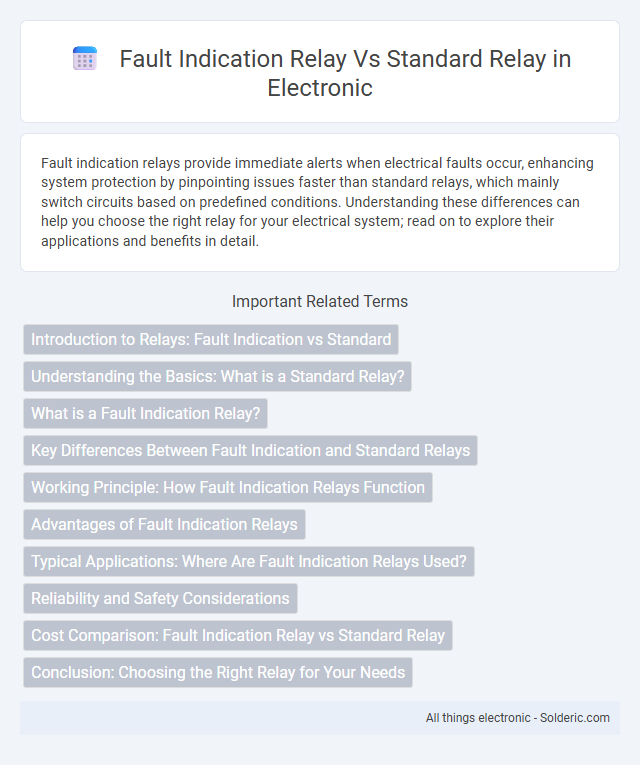Fault indication relays provide immediate alerts when electrical faults occur, enhancing system protection by pinpointing issues faster than standard relays, which mainly switch circuits based on predefined conditions. Understanding these differences can help you choose the right relay for your electrical system; read on to explore their applications and benefits in detail.
Comparison Table
| Feature | Fault Indication Relay | Standard Relay |
|---|---|---|
| Primary Function | Detects and indicates electrical faults | Switches electrical circuits on/off |
| Fault Detection | Yes, monitors fault conditions | No, operates on control signals only |
| Application | Power systems protection and fault signaling | General electrical switching |
| Output Signal | Fault indication alarm or trip signal | Mechanical or electrical contact actuation |
| Complexity | Advanced, includes sensing and logic | Basic mechanical/electrical switching |
| Use Case | Power distribution networks, substations | Control panels, motor starters, relays |
| Cost | Higher due to added functionality | Lower, simpler design |
Introduction to Relays: Fault Indication vs Standard
Fault indication relays are specialized devices designed to detect and signal electrical faults in power systems, enabling rapid identification and isolation of problematic sections to maintain system stability. Standard relays primarily perform basic protection functions by opening or closing circuits based on preset parameters without providing detailed fault diagnostics. Your choice between fault indication and standard relays impacts how quickly you can respond to electrical disturbances and ensure uninterrupted power supply.
Understanding the Basics: What is a Standard Relay?
A standard relay is an electromechanical switch used in electrical circuits to control a high-power device with a low-power signal, ensuring safe and efficient operation. It operates by energizing a coil to create a magnetic field, which pulls contacts together or apart, enabling circuit connection or disconnection. Understanding your standard relay's function is crucial for proper integration into control systems, where it serves as a fundamental component for switching and isolation tasks.
What is a Fault Indication Relay?
A Fault Indication Relay is a protective device designed to detect electrical faults such as short circuits or ground faults and provide immediate notification to operators. Unlike standard relays, which primarily perform switching operations based on control signals, fault indication relays are specifically engineered to identify abnormal current conditions and trigger alarms. These relays enhance power system reliability by enabling rapid fault localization and timely maintenance actions.
Key Differences Between Fault Indication and Standard Relays
Fault indication relays are designed to detect and signal electrical faults such as short circuits or ground faults rapidly, allowing for immediate isolation of the affected circuit to prevent damage. Standard relays primarily function as switches controlling circuit operation without inherent fault detection capabilities. The key difference lies in fault indication relays' specialized sensing elements and alarm contacts, which enable proactive fault management, whereas standard relays focus on general circuit control and protection coordination.
Working Principle: How Fault Indication Relays Function
Fault indication relays operate by detecting abnormal current or voltage patterns indicative of faults within electrical circuits, triggering alarms or circuit interrupters to prevent damage. These relays utilize sensors and internal logic to monitor parameters continuously, isolating faulted sections rapidly compared to standard relays, which primarily focus on basic overcurrent or voltage thresholds without fault localization capabilities. By analyzing fault signatures, fault indication relays enhance system protection and minimize downtime in complex electrical networks.
Advantages of Fault Indication Relays
Fault indication relays provide real-time detection and localization of electrical faults, reducing downtime and enhancing system reliability compared to standard relays. These relays enable faster fault isolation by sending immediate alerts, facilitating prompt maintenance and minimizing damage to equipment. Enhanced sensitivity and advanced diagnostic features in fault indication relays improve overall safety and operational efficiency in power distribution networks.
Typical Applications: Where Are Fault Indication Relays Used?
Fault indication relays are essential in power distribution systems, particularly in substations and industrial plants, where they detect and signal faults such as short circuits or ground faults to prevent equipment damage and ensure safety. Standard relays, while used for general-purpose control and automation, lack the specialized fault detection features required for high-voltage transmission lines and critical infrastructure monitoring. Your choice of a fault indication relay enhances system reliability by providing immediate fault alerts, enabling faster response and minimizing downtime.
Reliability and Safety Considerations
Fault indication relays offer enhanced reliability by quickly detecting and signaling electrical faults, reducing downtime and preventing equipment damage. Standard relays provide basic protection but may lack the advanced sensitivity and diagnostic features necessary for early fault detection. You benefit from improved safety and system integrity by choosing fault indication relays that enable faster response times and more accurate fault localization.
Cost Comparison: Fault Indication Relay vs Standard Relay
Fault Indication Relays typically incur higher upfront costs compared to Standard Relays due to advanced fault detection and diagnostic features embedded within their design. While Standard Relays offer basic switching functions with lower initial investment, they might lead to increased expenses over time due to less precise fault isolation and extended downtime. Your choice impacts both immediate budget and long-term operational efficiency, making the cost comparison crucial for informed electrical system planning.
Conclusion: Choosing the Right Relay for Your Needs
Fault indication relays provide precise detection and signaling of electrical faults, enhancing system protection and reducing downtime compared to standard relays that primarily perform basic switching functions. Selecting the right relay depends on the complexity of the electrical system, the need for rapid fault identification, and maintenance requirements. For critical applications demanding fast fault response and minimized outage time, fault indication relays offer superior reliability and diagnostic capabilities over standard relays.
Fault Indication Relay vs Standard Relay Infographic

 solderic.com
solderic.com